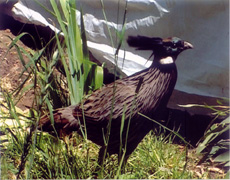
Text & photograph By Susan Sharma
The koklass is a medium-sized pheasant seen in India in Jammu and Kashmir, Himachal Pradesh and Uttaranchal. The koklass prefer dense undergrowth in fir spruce forest, though it also occurs in Oak Deodar areas. The chestnut breast, black head,
and white patches on the sides of the neck are unique, and the female also has a distinctive whitish patch along the side of the neck. The male's call in spring and summer is a loud pok-pok-pok . . . pokias, uttered mainly during morning and evening hours.
This species feeds on all kinds of grain, grass seeds, acorns, berries and buds, and also upon insects and worms.
There is a seasonal movement downward of approximately 1000 m, so that by February the birds are concentrated at about 2200-2500 m. This species apparently keeps very close to the same quarters, and may be found morning after morning and evening
after evening in the same open glades searching for food. The birds are monogamous, and apparently remain in pairs throughout much of the year. Further, once the chicks have hatched the male participates in brood-rearing and brood protection. Later writers
have generally confirmed the view that an extended monogamous mating system prevails in this species.
The male's territorial call is a distinctive kok-kok-kok- . .
In various parts of India the koklass breeds from April to June Evidently most birds lay from the middle of May about the end of June in this race. Most nests placed under thick bushes, usually of evergreens, on the sides of hills in coniferous
forests.
It is vulnerable to destruction of mature middle-altitude forests with thick undergrowth, its prime habitat. The species is not highly prized for its plumage, and it is apparently less prone to being trapped than are some of the other pheasants
of the area.